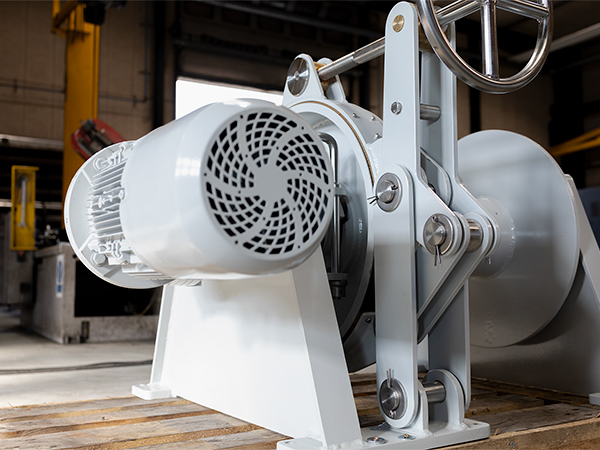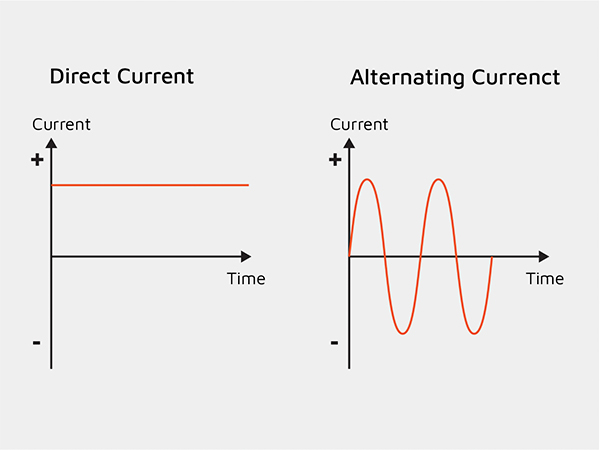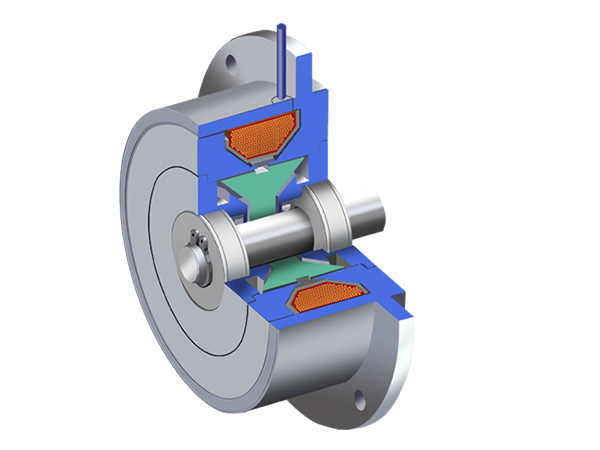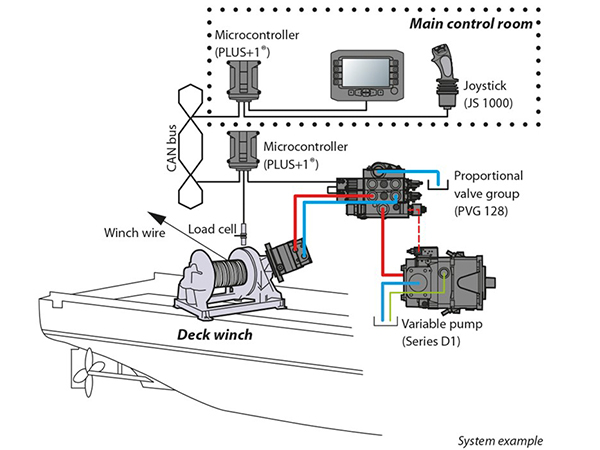Electric or Hydraulic Winch: Which is Better?
When it comes to choosing winches for maritime- or industrial use, there are two main options to consider: electric and hydraulic winches. Both electric and hydraulic winches are powerful winch equipment found on most larger vessels. For decades, hydraulic winches have been the preferred choice of professionals, but the efficiency and reliability of electric winches have become a viable alternative. In this blog, you will get insight into both types of winches and learn about their advantages and disadvantages.

AS SCAN anchor winch with electric motor and gearbox
In the past, customers have favored hydraulic winches, as it was a well-known- and reliable technology. As technology has caught up, the advantages of hydraulic systems are diminishing, and electric drives are being used in heavy-duty winches on increasingly demanding operations almost everywhere in the world.
Both of these types of winches have their advantages and disadvantages, so it's important to weigh them carefully before deciding.
How does an electric winch work?
An electric winch is powered by an electric motor that drives the drum to wind up the cable. The motors are powered by electricity which means that they operate on a power supply by either AC or DC systems. Direct current (DC) can come from multiple sources, including batteries, solar cells, fuel cells, and alternators. Alternating current (AC) power is the standard electricity that comes out of power outlets. Learn more about the difference between AC/DC.

Graph illustrating the difference between DC- and AC current
An important decision when you buy an electric motor is whether it should be a permanent magnetic motor or conventional electric motor. A PMDC (Permanent Magnet motor) has included a permanent magnet to form the magnetic field necessary for the motor operation, instead of it being created in stator windings.
PM motors
Winches with newly the developed permanent magnet (PM) motor technology offers a remarkable amount of torque at lower speeds. Consequently, a smaller reduction ratio is required in the gearbox, resulting in reduced system inertia. This, in turn, contributes to exceptional dynamic performance and responsiveness, which are particularly crucial for workboats and fishing vessels.
If you want to know more about PM motors, watch this:
If you want to know how a conventional electric motor works, watch this:
The electric motor is mounted locally directly on the winch, which of course places demands on the motor's durability depending on the environment it has to perform in. Therefore, you often see that industrial electric winches are powerful and robust with a strong and stable electrical system that can handle a lot load.
Electric motors have a high rpm and therefore must have a reduction gear that enable them to pull up extremely heavy loads.
Winches can have any type of gear assembly, but majority of the heavy duty winches uses planetary gear trains or elliptical gears. A reduction gear works by making the engine turn a high speed pinion against a gear, reducing the high rotational speed from the electric motor to lower rotational speed for the winch. The amount of reduction is based on the number of teeth on each gear. For example, a pinion with 10 teeth, turning a gear with 40 teeth, must turn 4 times in order for the larger gear to turn once. This reduces the speed by a factor of 4 while raising the torque 4 fold.
For safety reasons, many choose to have it installed an power-off braking. They are sometimes referred to as failsafe brakes since they engage when power is cut.

Electromagnetic brake to be mounted on an electric motor
Fail-safe brakes automatically stop movement when power is removed and are beneficial in applications where quick and accurate braking or holding is required. When the power is re-engaged, the brake will release allowing the shaft to rotate or movement to continue.
What are the benefits of electric winch?
One of the main advantages of electric winches is that they save energy has less environmental impact and are quiet. They do not use any oil which makes them ideal for use fore eco-friendly companies. Electric winches are also very efficient and can be used for a variety of tasks, such as pulling heavy nets or anchor handling operations.
Here are listed the pros of electric winch:
- Lower installation cost versus a hydraulic system
- Electric power is clean, eliminating the risk of hydraulic fluid leaks and environmental concern.
- Programmable speeds and stop positions
- Variable frequency drive offers precise control and feedback on motion and force
- Quiet operation and the need for noisy HPU is eliminated.
- Excess electrical power can be used to power equipment
What are disadvantages of electric winch?
However, electric winches do have some disadvantages. Electric winches are generally more expensive than hydraulic winches. They can be slower than hydraulic winches, especially when under heavy loads. They also require a reliable source of power, such as a large generator, which can be a problem on a vessel.
Here are a list of cons to electric winch:
- Appropriate power for the winch might not be readily available and can be expensive to get.
- Variable frequency drives are a more expensive option than a hydraulic pilot valve to control load movement for applications where variable speed is desirable
- Complex electric installation and troubleshooting difficulties
- Install and repairs often require an electrician or engineer
- Electric motor components have sensitivity to water, dust, dirt, and other contaminants
- A gearbox may be required to obtain the right speed and pull
- The size motor needed for high torque may be impractical
- Oversized motors needed to meet the maximum load requirements
- Electric motors must be mounted close to the winch
How does a hydraulic winch work?
A hydraulic winch works by utilizing the power of a hydraulic system to generate the mechanical force needed to pull or lift objects. The main components involved in this process are a hydraulic pump, a motor, a drum, wire rope, and the control valve.
- Hydraulic pump: The core of the device; it converts mechanical energy from the engine or electric motor into hydraulic energy by moving hydraulic fluid through the system under pressure.
- Motor: This component receives pressurized hydraulic fluid from the pump and transfers the energy generated to the winch drum. The motor converts hydraulic energy back into mechanical energy and provides the torque required for winching operations.
- Drum: The cylindrical, revolving part of the winch that spools and unwinds the wire rope. The rotation of this drum is responsible for pulling or lifting objects when using the winch.
- Control valve: This component regulates and directs the flow of pressurized hydraulic fluid to various parts of the winch system, ensuring smooth and efficient operation.
When performing a winching task, an operator activates the hydraulic pump which increases pressure within the system by pushing fluid through it. This pressurized fluid flows to the motor, causing it to rotate, which in turn spins the drum. As the drum rotates, it winds or unwinds the wire rope around its core.
The direction of operation can be changed by adjusting control valves which redirect hydraulic fluid flow accordingly. Additionally, varying pressure levels can be used to control pulling force and speed during a task. To stop a winching operation, an operator can simply release pressure from within the system or lock up controls as required.
AS SCAN technician install a 170cc motor and gear on a winch, watch this:
The pump can be placed externally from the winch in, for example, a power pack (HPU) or PTO on a gearbox. When the motor rotates, the wire can be spooled onto the drum.

An example of a maritime hydraulic system. Source Danfoss
What is the advantage of a hydraulic winches?
One significant advantage of hydraulic motors is their large power-to-size ratio, as they take up less space than an electric motor setup. They can handle heavy loads with ease and are ideal for commercial use. Additionally, hydraulic motors are efficient and durable and have a wider operating temperature of -50° to +100° C

AS SCAN anchor winch with hydraulic motor and gear box installed on Norwegian fishing vessel
Here are listed the pros of hydraulic motors:
- Generation of very high output force in comparison to input force
- Can function optimally in harsh environments
- Capable of slow and precise movements while moving heavy loads
- High torque capacity despite a system that is a fraction of an electric motor’s size
- Uses no power while holding a standstill load
- Remote mounting is a possibility. Only the accumulator, actuator, and control valves must be located near the application close
What are the disadvantages of hydraulic winches?
However, hydraulic winches do have some disadvantages. Hydraulic components, pipes, pipe support, flanges and valves are more complicated to install.
They also require large hydraulic pumps to move the hydraulic oil which is either mounted on the gearbox or powered by an electric motor. A hydraulic system makes more noise which can be a nuisance to the crew and impair the working environment.
Here are a list of cons to hydraulic motors:
- High cost of installation
- More maintenance and cleaning needed, especially for the filters, hydraulic pumps, and oils
- Hydraulic fluid leaks increase safety hazards environmental impact
- Hydraulic systems require multiple components, including actuators, accumulators, release valves, and the hydraulic fluid
- Very noisy operation and high vibration
- The hydraulic fluid requires frequent inspections, cleaning, and top ups
- More lost efficiency due to heat loss
Should I choose an electric- or hydraulic winch?
These pros and cons lists can seem to decide between a hydraulic- or electrical motor difficult. The choice should be easier when you consider the application, space available, and maintenance requirements. In the end, the choice between electric and hydraulic winches depends on your specific needs and preferences. If you have sufficient electric power and need a winch that is quiet and clean, an electric winch may be the best option. If you need a winch that is powerful, reliable and less expensive to purchase a hydraulic winch may be the better choice.
In short you need to consider the following questions:
- Which power source do you have available?
- Do you require a winch for long-term and hard use?
- In what environment will the winch be used in - will i be exposed to salt water?
- The financial considerations
The two technologies will always live side-by-side for the foreseeable future. Electrical systems will be a better choice in some areas but there are still plenty of applications where it is better to have hydraulic systems.
No matter which type of winch you choose, it's important to invest in a high-quality winch that is built to last. A good winch can make all the difference when it comes to safety and performance on the water.
Regardless of what type of winch you use – hydraulic or electric – the type of rope used will play a factor in your decision as well. Want to learn more about how to choose winch cable then read our compressive guide.

